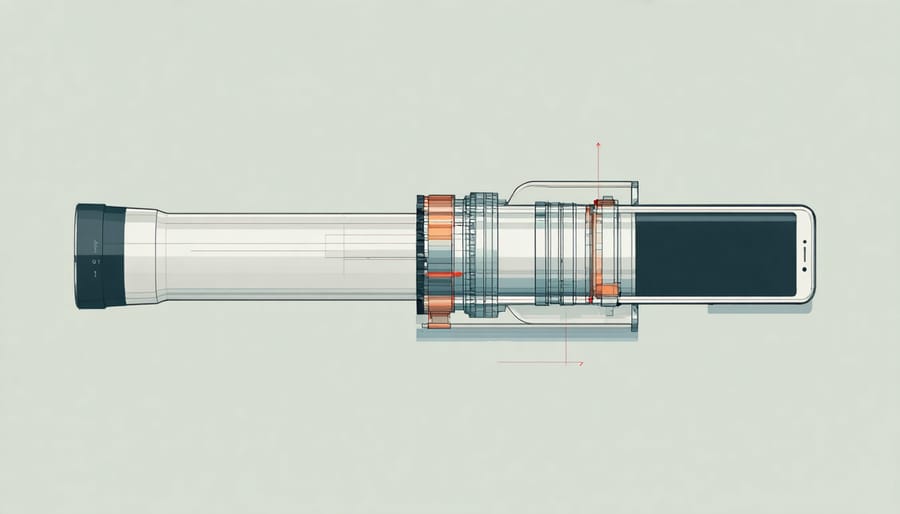
Lens development stands at the forefront of modern photography’s evolution, pushing the boundaries between what we imagine and what we can capture. From revolutionary optical designs that complement advanced digital camera sensors to groundbreaking materials science, today’s lens innovation represents a perfect fusion of artistic vision and engineering precision.
The past decade has witnessed unprecedented advances in lens technology – from ultra-compact wide-aperture designs to intelligent autofocus systems that track subjects with uncanny accuracy. These developments aren’t just incremental improvements; they’re fundamentally changing how photographers approach their craft, enabling previously impossible shots and opening new creative possibilities.
As we stand at this technological crossroads, understanding lens development becomes crucial for anyone serious about photography. Whether you’re capturing the subtle nuances of portrait photography or pushing the limits of astronomical imaging, modern lens technology is redefining what’s possible through the viewfinder.
This exploration of lens development will demystify recent innovations, examine current trends, and peek into the future of optical engineering. From computational optics to advanced coating technologies, we’ll discover how these developments are shaping the future of photography and why they matter to both professional photographers and enthusiasts alike.
Computational Lens Technology
AI-Powered Autofocus Systems
The rapid evolution of digital photography has revolutionized how we capture images, and nowhere is this more evident than in modern autofocus systems. Today’s AI-powered focusing technology represents a quantum leap forward, offering photographers capabilities that seemed like science fiction just a decade ago.
At the heart of these advances is deep learning technology, which enables cameras to recognize and track subjects with unprecedented accuracy. Modern mirrorless cameras can now identify and lock onto human eyes, even when subjects are wearing masks or glasses, and maintain focus as they move through the frame. This technology has expanded beyond human subjects, with many systems now capable of recognizing and tracking animals, birds, and vehicles with remarkable precision.
What makes these systems truly revolutionary is their ability to learn and adapt. Through sophisticated algorithms, they can predict subject movement patterns and adjust focus accordingly, ensuring sharp images even in challenging conditions. For wildlife photographers, this means being able to capture birds in flight with consistent accuracy, while sports photographers can rely on their gear to track athletes across complex movement patterns.
Real-time eye detection has become particularly sophisticated, with some systems able to switch seamlessly between multiple subjects in the frame, prioritizing faces based on composition and proximity. This intelligence extends to video recording as well, where continuous AI-driven autofocus ensures smooth focus transitions and consistent subject tracking.
For photographers transitioning from older systems, these advances mean spending less time wrestling with focus points and more time composing shots and connecting with subjects. The technology effectively removes one of the most technical aspects of photography, allowing creators to focus on their artistic vision.

Software-Enhanced Optical Correction
Modern lens design has entered an exciting new era where optical engineering meets computational power. Software-enhanced optical correction represents a revolutionary approach to addressing traditional lens limitations, combining physical optics with sophisticated algorithms to deliver superior image quality.
Today’s high-end lenses incorporate built-in processors that work in real-time to analyze and correct various optical imperfections. These smart systems can detect and compensate for common issues like chromatic aberration, distortion, and vignetting before the image even reaches your camera’s sensor. What’s particularly impressive is how these corrections adapt to different shooting conditions and focal lengths.
Lens manufacturers now develop their glass elements in tandem with correction profiles and firmware updates. This symbiotic relationship between hardware and software means that lens performance can actually improve over time through updates, something unthinkable in the purely mechanical era of photography.
One of the most significant advantages of software-enhanced correction is its ability to address complex optical issues that would be prohibitively expensive or physically impossible to solve through glass elements alone. For instance, modern algorithms can correct for focus breathing during video recording or compensate for diffraction effects at smaller apertures.
The technology isn’t limited to just correcting flaws; it’s also enabling new creative possibilities. Advanced lens systems can now maintain consistent exposure during zoom operations, provide real-time distortion correction for architectural photography, and even optimize bokeh characteristics based on scene recognition.
While purists might debate the role of software in lens design, the results speak for themselves: sharper images, reduced aberrations, and more reliable performance across all shooting conditions. This marriage of optical science and digital technology continues to push the boundaries of what’s possible in photography.
Advanced Materials Revolution
Nano-Crystal Coatings
One of the most significant breakthroughs in modern lens technology has been the development of nano-crystal coatings, which have revolutionized how lenses handle unwanted light. These microscopic crystalline structures, often just nanometers in size, work like tiny light managers, precisely controlling how light rays interact with the lens surface.
Traditional lens coatings were good at reducing basic flare and ghosting, but nano-crystal coatings take this capability to an entirely new level. Imagine thousands of perfectly arranged molecular structures that can differentiate between useful and unwanted light rays, effectively eliminating internal reflections that would otherwise create distracting artifacts in your images. This technology has been particularly transformative for low-light performance, where every photon counts.
Professional photographers have reported significant improvements in contrast and color accuracy when using nano-coated lenses, especially in challenging lighting conditions like backlit portraits or landscape photography during golden hour. The coating’s effectiveness is most noticeable when shooting directly into light sources, where traditional lenses might struggle with veiling flare and loss of detail.
The manufacturing process involves depositing multiple layers of these nano-structures in precise patterns across the lens elements. Each layer serves a specific purpose, from managing different wavelengths of light to protecting the lens surface from environmental factors. What’s particularly impressive is how these coatings maintain their effectiveness across varying angles of incident light, something that earlier coating technologies struggled to achieve.
Beyond image quality improvements, nano-crystal coatings also offer practical benefits like enhanced durability and easier cleaning. The molecular structure of these coatings creates a smoother surface that’s more resistant to fingerprints and water, making maintenance simpler for photographers working in challenging conditions.

Exotic Glass Elements
Glass has always been at the heart of lens development, but modern exotic glass elements are revolutionizing what’s possible in lens design. These specialized materials, developed through advanced manufacturing processes, offer unique optical properties that help overcome traditional limitations in lens performance.
One of the most significant innovations is Extra-low Dispersion (ED) glass, which dramatically reduces chromatic aberration – that unwanted color fringing that can appear around high-contrast edges in photos. ED glass elements allow light of different wavelengths to pass through with minimal separation, resulting in sharper images with better color accuracy.
Fluorite crystal elements, though expensive to produce, represent another breakthrough in lens technology. These elements offer extraordinary light transmission and dispersion characteristics that are difficult to achieve with conventional optical glass. Canon, in particular, has been a pioneer in using fluorite elements in their premium telephoto lenses, delivering exceptional clarity and contrast.
High-refractive index glass is another game-changer. These elements can bend light more effectively than traditional glass while maintaining a smaller size and lighter weight. This property allows lens designers to create more compact lenses without sacrificing optical quality – a crucial factor in today’s mirrorless camera systems.
Aspherical elements made from exotic glass compounds help correct spherical aberration and distortion while reducing the number of elements needed in a lens. This not only improves image quality but also contributes to creating lighter, more compact designs that are easier to handle in the field.
The latest development in exotic glass technology is the incorporation of nano-crystal coatings. These microscopically thin layers help reduce internal reflections and ghost imaging, particularly when shooting in challenging lighting conditions. Nikon’s Nano Crystal Coat and Canon’s Air Sphere Coating are prime examples of how these advanced materials are pushing the boundaries of lens performance.
Miniaturization Breakthroughs
Folded Optics Technology
Folded optics technology is revolutionizing how we think about telephoto capabilities in modern cameras, particularly in smartphones and compact cameras where space is at a premium. By using a series of precisely positioned mirrors or prisms, these innovative designs effectively “fold” the light path, allowing manufacturers to fit longer focal lengths into significantly thinner devices.
Think of it like a periscope in a submarine – light enters through one opening, travels along a zigzag path, and exits through the lens. This clever arrangement means a 5x or even 10x optical zoom can fit into a space just a few millimeters thick, solving one of the biggest challenges in mobile photography: achieving true optical zoom without excessive bulk.
Recent developments in folded optics have led to impressive achievements, such as periscope zoom lenses that offer 120mm to 240mm equivalent focal lengths in smartphones less than 9mm thick. The technology isn’t just about making things smaller – it’s also improving image quality. By using specialized lens elements and advanced coatings along the folded light path, manufacturers can reduce aberrations and enhance overall optical performance.
The impact of this technology extends beyond mobile devices. Camera manufacturers are exploring folded optics for compact cameras and even some interchangeable lens designs, potentially leading to smaller, more portable professional gear without sacrificing image quality.

Compact High-Performance Designs
In recent years, lens manufacturers have achieved remarkable breakthroughs in creating compact yet high-performance lenses, addressing the long-standing challenge of balancing size with optical quality. These innovations stem from advanced computer-aided design and new glass materials that allow for shorter light paths while maintaining exceptional image quality.
Modern optical formulas now incorporate aspherical elements and specialized lens coatings that effectively correct aberrations without requiring numerous glass elements. This approach has led to the development of professional-grade lenses that are up to 40% smaller than their traditional counterparts. For instance, several manufacturers have introduced f/1.8 prime lenses that deliver outstanding sharpness while being surprisingly compact.
The rise of mirrorless camera systems has particularly accelerated this trend, as the shorter flange distance allows for more efficient optical designs. Engineers have leveraged this advantage to create pancake lenses and ultra-compact zooms that were previously impossible with DSLR configurations.
New manufacturing techniques, including precision molding of aspherical elements and the use of lightweight composite materials, have also contributed to this evolution. These advances don’t just reduce size – they often improve image quality by minimizing internal reflections and reducing chromatic aberration.
For photographers, these compact designs mean less fatigue during long shoots without sacrificing image quality, making them particularly valuable for street, travel, and documentary photography.
Future Innovations on the Horizon
Liquid Lens Technology
Imagine a lens that can change its focal length without any moving parts – that’s the magic of liquid lens technology. These innovative optical elements use the interaction between two immiscible liquids (typically water and oil) to create a variable focal length system that can adjust focus instantly through electrical stimulation.
The principle behind liquid lenses is called electrowetting, where applying an electrical charge changes the surface tension between the liquids, altering the shape of their interface. This shape change directly affects how light passes through the lens, allowing for rapid focusing adjustments without any mechanical movement.
What makes liquid lenses particularly exciting is their potential for miniaturization and durability. With no moving parts to wear out, these lenses can be made incredibly small while maintaining high reliability. This technology has already found applications in smartphone cameras, medical devices, and industrial automation systems.
The benefits are compelling: near-instantaneous focus changes, reduced power consumption, and exceptional durability. However, current limitations include temperature sensitivity and the challenge of maintaining consistent optical quality across the entire focal range.
Recent developments have seen manufacturers combining liquid lens elements with traditional glass optics to create hybrid systems that offer the best of both worlds. These systems maintain the optical clarity of conventional lenses while adding the flexibility of variable focus.
Looking ahead, liquid lens technology promises to revolutionize areas like augmented reality displays, autonomous vehicle vision systems, and next-generation mobile device cameras. As the technology matures, we’re likely to see increasingly sophisticated applications that take advantage of these adaptive optical systems.
Metalens Development
One of the most exciting breakthroughs in lens technology is the development of metalenses, ultra-thin optical elements that could revolutionize how we capture images. Unlike traditional glass lenses that rely on curved surfaces to manipulate light, metalenses use precisely engineered nanostructures arranged on a flat surface to control light waves at the microscopic level.
These innovative optical devices are incredibly thin – often just a fraction of a millimeter thick – yet they can perform the same functions as conventional lenses that are significantly bulkier. The nanostructures, typically made from materials like titanium dioxide or silicon, are arranged in specific patterns that can bend, focus, and manipulate light in ways that were previously impossible with traditional optics.
The potential benefits of metalenses are substantial. Their compact nature could lead to dramatically slimmer cameras and mobile devices without sacrificing image quality. They’re also easier to manufacture at scale using existing semiconductor fabrication techniques, potentially making high-quality optics more accessible and affordable.
Recent developments have shown promising results in addressing previous limitations, such as chromatic aberration and narrow viewing angles. Researchers have successfully created metalenses that can focus the entire visible spectrum of light, a crucial breakthrough for practical photography applications.
While metalenses aren’t yet available in consumer cameras, ongoing research suggests we might see them in smartphones and compact cameras within the next few years. This technology could particularly benefit areas like medical imaging, AR/VR headsets, and satellite systems, where size and weight constraints are crucial considerations.

The journey of lens development has transformed photography in ways that early pioneers could hardly have imagined. From the introduction of autofocus systems to the latest computational photography innovations, each breakthrough has expanded creative possibilities while making advanced photography more accessible to enthusiasts of all skill levels.
Today’s photographers benefit from unprecedented optical quality, with innovations like nano-coating technology and advanced glass elements delivering superior image quality in increasingly compact designs. The integration of image stabilization, silent focusing motors, and intelligent tracking systems has revolutionized both still photography and videography, enabling creators to capture moments that were once technically impossible.
Looking ahead, the future of lens development appears even more promising. Artificial intelligence and machine learning are already beginning to influence lens design and performance, with manufacturers developing smarter optics that can adapt to shooting conditions in real-time. We’re likely to see continued miniaturization of professional-grade lenses, making high-end optical performance more portable and accessible.
Emerging technologies like liquid lenses and metamaterial optics could fundamentally change how we think about lens construction. These innovations might lead to lenses that can instantly change their focal length without moving parts, or ultra-thin optics that deliver exceptional image quality in previously impossible form factors.
As we move forward, the emphasis on environmental sustainability and ethical manufacturing practices will likely influence lens development, pushing manufacturers to explore eco-friendly materials and production methods. This evolution in lens technology continues to enhance the photographic experience, making it easier than ever for photographers to realize their creative vision while pushing the boundaries of what’s possible in image-making.





















